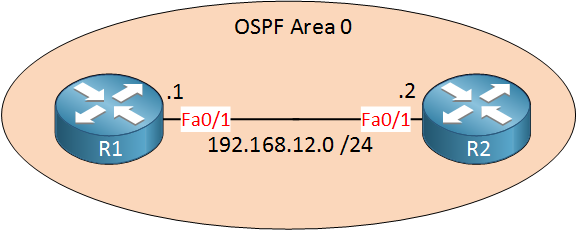How to configure OSPF Default Route
With OSPF, it is no problem to configure a default route. There are a couple of options if you want to do this. Here’s an example:

R1(config)#router ospf 1
R1(config-router)#default-information originate ?
always Always advertise default route
metric OSPF default metric
metric-type OSPF metric type for default routes
route-map Route-map reference
<cr>There are a number of things. We can change the metric or metric type, but the most important thing most people forget is the always keyword.
If you use the default-information originate command, you can advertise a default route in OSPF. OSPF won’t advertise a default route if you don’t already have it in your routing table. If you add the always keyword, it will advertise the default route even if you don’t have it in the routing table. Once you have advertised the default route, it will look like this on other routers:
R2#show ip ospf database | begin Type-5
Type-5 AS External Link States
Link ID ADV Router Age Seq# Checksum Tag
0.0.0.0 172.16.3.1 59 0x80000001 0x008D64 1
R2#show ip route ospf
O*E2 0.0.0.0/0 [110/1] via 192.168.12.1, 00:00:24, FastEthernet0/0It will show up as an LSA type 5 external route.
Unit 1: Introduction to OSPF
- Introduction to OSPF
- Basic OSPF Configuration
- OSPF Multi Area Configuration
- OSPF Reference Bandwidth
- OSPF Plain Text Authentication
- OSPF MD5 Authentication
- OSPF SHA-HMAC Authentication
- OSPF TTL Security Check
- OSPF Default Route
Unit 2: OSPF Neighbor Adjacency
- OSPF LSA Types
- OSPF LSAs and LSDB Flooding
- OSPF Hello and Dead Interval
- OSPF Router ID
- OSPF Packets and Neighbor Discovery
- OSPF DR/BDR Election
- OSPF Passive Interface
- Troubleshooting OSPF Neighbor Adjacency
Unit 3: OSPF Network Types
- OSPF Non-Broadcast Network Type
- OSPF Broadcast Network Type
- OSPF Point-to-Multipoint Network Type
- OSPF Point-to-Multipoint Non-Broadcast Network Type
- OSPF Point-to-Point Network Type
- OSPF Next Hop with Network Types
Unit 4: OSPF Stub Areas
- Introduction to OSPF Stub Areas
- How to configure OSPF Stub Area
- How to configure OSPF Totally Stub
- How to configure OSPF NSSA (Not So Stubby) Area
- How to configure OSPF Totally NSSA (Not So Stubby) Area
- OSPF NSSA P-bit explained
Unit 5: Advanced OSPF Topics
- OSPF Summarization
- OSPF Distribute-List Filtering
- OSPF LSA Type 3 Filtering
- OSPF LSA Type 5 Filtering
- OSPF Virtual Link
- OSPF Virtual Link Authentication
- OSPF Path Selection Explained
- How to read the OSPF Database
- OSPFv3 for IPv4
- Troubleshooting OSPF Route Advertisement
- OSPF SPF Scheduling and Throttling
- OSPF LSA Throttling
- OSPF Incremental SPF
- OSPF Prefix Suppression
- OSPF Stub Router
- OSPF Graceful Shutdown
- OSPF Graceful Restart
- OSPF Loop-Free Alternate (LFA) Fast Reroute (FRR)
- OSPF Remote Loop-Free Alternate (LFA) Fast Reroute (FRR)